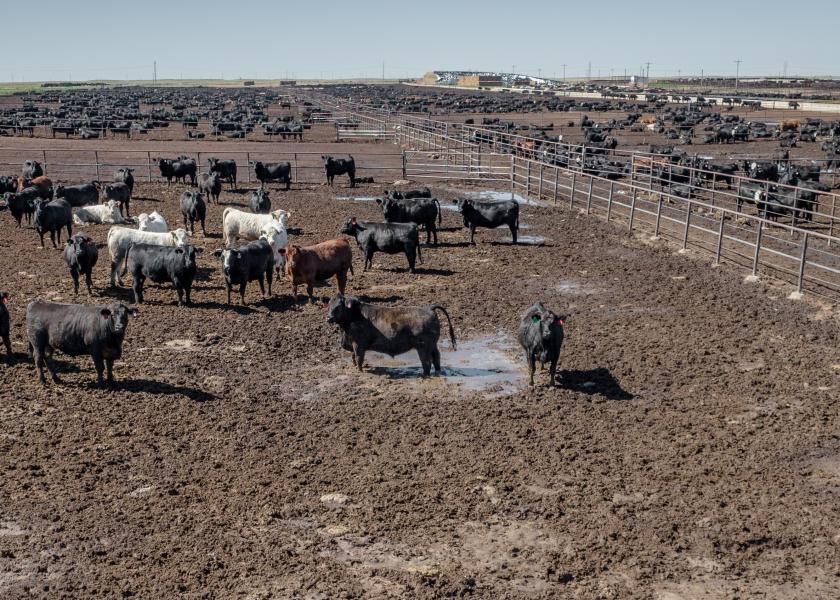Tips for Dealing with Wet, Muddy Feedlot Conditions

In unexpected warm, wet winter conditions cattle face challenges accessing feed, water, or a place to lie down. Muddy conditions affect requirements for maintenance, according to this UNL study. Even if feed intake is not affected by muddy conditions (cattle can reach the bunk and water trough and consume a full ration daily), mud depths of less than 9 inches increase maintenance requirements up to 80%. This means that cattle consuming a finishing diet containing 1 Mcal NEm/lb will require nearly double the amount of feed to meet their maintenance requirements or 19 lb for a 1,400-lb steer. In many cases, intake is affected by muddy conditions and 19 lb may not be achievable, leading cattle to lose weight.
That's why it's important to reduce the effects of mud and standing water in pens as soon as possible. Inherently, pen conditions are dictated by siting, orientation, fence type, and percentage of solid surfacing around bunks, water tanks, access points and loafing areas. Therefore, strategies to reduce the effect of mud and standing water on cattle performance are listed below for worst to best pen conditions:
Suggestions for worst pen sites
(flat, heavily stocked or with standing water and/or with less than 1/3 of the pen are as solid surfacing):
- Remove lightweight cattle to pastures or corn stalk fields stocking at a rate of 1 acre per head on hilly ground or 2 or more acres per head on flat ground.
- On pens made available by this strategy, scrape solid surfacing to the bare material (concrete or bituminous) and bed heavily before permitting access to heavier or newly received cattle housed yet in adjacent pens (continue to feed only the home pen).
- If this is not possible, simply lay whole round bales of bedding or even hay on areas with less mud. Cattle will work the material off, using it for bedding and feed. Continue this strategy until weather conditions improve.
Suggestions for average pen sites
(with some slopes for loafing areas, stocked lighter and/or more than 1/3 of the pen are as solid surfacing)
- All aprons and surfaced areas, scrape down to the surface. This is a minimum to let cattle find a spot to lie down.
- Aprons need to be scraped two to four times weekly. On wide aprons (over 20'), lay bedding down heavily after scraping in areas beyond the first 20’ behind the bunk.
- If forming a bed pack, only bed when pack begins to seep. Dry or sticky packs are still functional as bedding.
- Scrape any scattered (not heavily wet) bedding onto bed pile. Bed on top of it.
To make additional "emergency" hard surfaces (applicable to both pen conditions described above):
- Potential areas to enhance surfacing: behind bunk or water tank aprons or on top of mounds if accessible (don't attempt to build a hard surface on hillsides unless machinery can safely drive over it).
- Alternatively, consider ground-cover mats like this or this used to move heavy construction equipment over a ground surface. Make sure this “path” is in place before attempting to improve a site within the pen.
- Scrape down below surface line about 1', attempting to remove excess accumulated manure and mud.
- Lay down recycled concrete to the depth of 6". Bed heavily on top of this. A 25' by 25' area filled to a 6" depth will need 16 ton of recycled concrete (one short truck load; about $500 for concrete).
- Alternatively, one might consider using railroad ties to create the base. About $30 each at retail price.
- Dimensions are 8' x 7" x 9", so a 48' x 3' surface made from ties would require 24 ties or $720.
- A square design is recommended for recycled concrete (to prevent excess scattering), while a long rectangle shape is recommended when forming a base with ties to keep them tucked together in a narrow path.
- Bed any emergency surfaced areas generously. The prorated rate of bedding to achieve a working bed pack is 4 lb per head daily or more. Any bedded areas must be rebedded regularly, particularly on areas with no surfacing. Lapses in bedding will create worse conditions even on surfaced areas.
- Areas where recycled concrete is laid should be managed separately when cleaning manure from pens. They can be left installed permanently and managed as an extension of the apron (recycled concrete tends to “set” together with traffic and moisture) or power washed and surfaced with concrete when weather improves.
- Ties can be lifted when weather improves (and before extending the area using concrete) and be used for other purposes.
Note: these are emergency recommendations to improve pen conditions rapidly and are not tested by scientific procedures. In the example dimensions provided above, and assuming 24 ft2 are needed to fit one animal, no more than 25 head will be able to access this area at one time at a cost of between $500 to $1,000.
Yet, considering the value gain resulting from fed cattle prices increase since the beginning of the year results in a $75 increase in value per head. Investments at or below this level to preserve the performance and life of a $2,700 animal are well advised.
More resources about managing feedlot cattle in muddy conditions.







